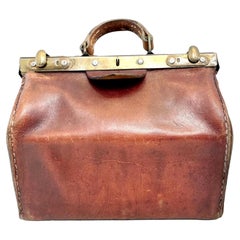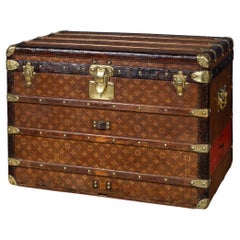Trunks and Luggage
1940s French Rustic Vintage Trunks and Luggage
Brass
Early 1900s Art Deco Antique Trunks and Luggage
Leather
20th Century French Other Trunks and Luggage
Brass
20th Century German Mid-Century Modern Trunks and Luggage
Brass
1940s American Colonial Revival Vintage Trunks and Luggage
Brass
20th Century French Other Trunks and Luggage
Brass
20th Century French Other Trunks and Luggage
Brass
20th Century Spanish Art Deco Trunks and Luggage
Metal
1930s European Hollywood Regency Vintage Trunks and Luggage
Brass
Mid-20th Century Moroccan Islamic Trunks and Luggage
Pine, Paint
Early 20th Century French Trunks and Luggage
Leather
20th Century French Modern Trunks and Luggage
Leather
1920s French Vintage Trunks and Luggage
Brass
1920s French Vintage Trunks and Luggage
Brass
Early 20th Century Scottish Edwardian Trunks and Luggage
Leather, Canvas
1970s French Vintage Trunks and Luggage
Chrome
Early 20th Century French Trunks and Luggage
Brass
1990s French Modern Trunks and Luggage
Brass
20th Century French Modern Trunks and Luggage
Brass
Mid-20th Century Mid-Century Modern Trunks and Luggage
Leather
Mid-20th Century British Trunks and Luggage
Crocodile, Leather
Early 20th Century British Mid-Century Modern Trunks and Luggage
Leather
Mid-20th Century American Art Deco Trunks and Luggage
Aluminum
20th Century French Other Trunks and Luggage
Brass
Mid-20th Century British Art Deco Trunks and Luggage
Brass
1980s French Modern Vintage Trunks and Luggage
Leather
Early 1900s British British Colonial Antique Trunks and Luggage
Faux Leather
1960s French Mid-Century Modern Vintage Trunks and Luggage
Faux Leather
20th Century French Other Trunks and Luggage
Brass
Early 20th Century American Trunks and Luggage
Metal
20th Century French Other Trunks and Luggage
Brass
1930s English Art Deco Vintage Trunks and Luggage
Crocodile, Textile
Early 20th Century Tanzanian Tribal Trunks and Luggage
Brass
20th Century French Trunks and Luggage
Metal, Brass
1920s French Industrial Vintage Trunks and Luggage
Brass
Early 20th Century Mexican Trunks and Luggage
Pine
1920s French Vintage Trunks and Luggage
Brass
20th Century French Other Trunks and Luggage
Brass
Early 20th Century American American Empire Trunks and Luggage
Brass
Early 20th Century Trunks and Luggage
Hardwood
Mid-20th Century Indian Anglo-Indian Trunks and Luggage
Wire
1920s French Vintage Trunks and Luggage
Brass
1920s French Vintage Trunks and Luggage
Brass
Early 20th Century French Art Deco Trunks and Luggage
Metal
Early 20th Century French Trunks and Luggage
Brass
20th Century French Trunks and Luggage
Metal
Mid-20th Century Canadian Mid-Century Modern Trunks and Luggage
Brass, Chrome
1940s French Mid-Century Modern Vintage Trunks and Luggage
Brass
Mid-20th Century American Mid-Century Modern Trunks and Luggage
Aluminum
20th Century French Modern Trunks and Luggage
Leather, Mirror
Early 20th Century British Trunks and Luggage
Leather
20th Century American Mid-Century Modern Trunks and Luggage
1920s French Art Deco Vintage Trunks and Luggage
Leather
Early 1900s English Arts and Crafts Antique Trunks and Luggage
Oak
Late 20th Century Modern Trunks and Luggage
Brass
Early 20th Century Hungarian Rustic Trunks and Luggage
Iron
1980s Italian Vintage Trunks and Luggage
Leather, Crocodile
1910s French Vintage Trunks and Luggage
Brass
Antique and Vintage Trunks and Luggage
Add a charming piece of travel history to your space. Antique and vintage trunks and luggage can make a statement as decorative accents and practical furnishings in nearly every room of your home.
There have been many types of trunks and luggage over the years, with availability of these wares broadening as train travel expanded during the 19th century. Antique steamer trunks — named for their use on steamships — mostly date from around 1880 to 1920. These pieces of luggage fit a steamship’s luggage size regulations and essentially doubled as wardrobes, ensuring that a traveler’s evening dresses and suits were kept wrinkle-free on a journey from city to city.
In 1858, French luxury brand Louis Vuitton introduced the world to the now-iconic Louis Vuitton trunks. During this early period of railroad travel, Louis Vuitton trunks solved common travel problems. Instead of the traditional round shape, these handcrafted rectangular trunks stored better on trains. To discourage burglars, the French craftsman and his son, Georges, also eventually patented a revolutionary sophisticated lock for the trunks. The famous LV monogram was first used in 1896 as part of an initiative by Georges to prevent counterfeiting of his coveted travel trunks.
Even if no longer used for travel, the vintage luggage is a popular item among collectors for its historical value and charm. At home, an old wood trunk is a durable storage solution as much as it is a versatile surface. It’s a coffee table in the living room of your farmhouse-style home or rustic loft apartment and a nightstand or blanket chest at the foot of your bed in your bedroom.
From Victorian trunks to Art Deco traveling jewelry cases, journey through history today with an extensive collection of antique trunk suitcases and vintage luggage on 1stDibs.





